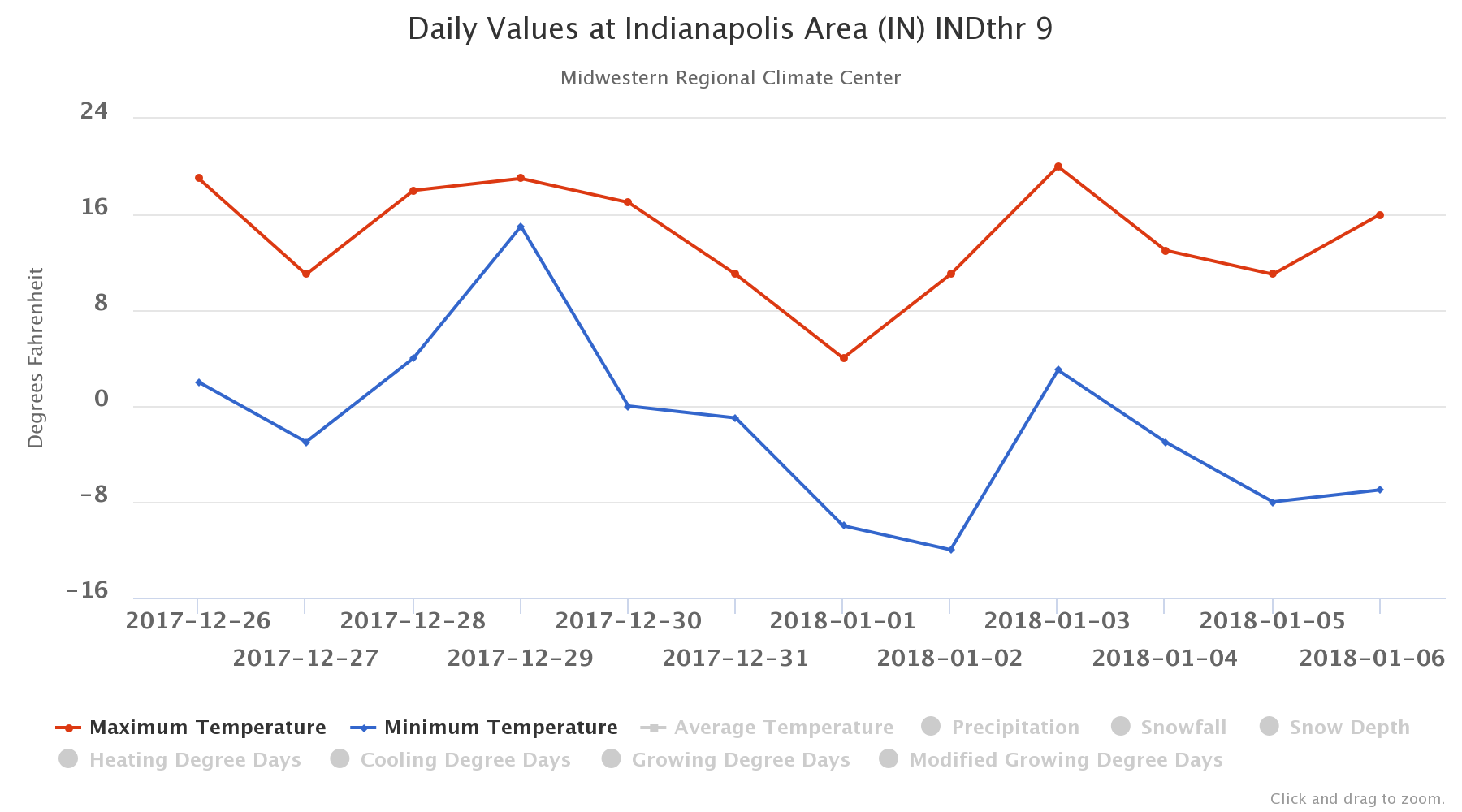Indianapolis, IN
Weather Forecast Office
The last week of December 2017 and the first week of January 2018 saw arctic air flow into central Indiana, providing some of the coldest temperatures in about 4 years.
The upper level atmosphere flow allowed air straight from the arctic to flow into the area. Temperatures plunged to well below zero, with even colder wind chills.
Below are some data and facts about the cold spell...
Daily High/Low Temperatures for each day:
| City | Dec 26 | Dec 27 | Dec 28 | Dec 29 | Dec 30 | Dec 31 | Jan 1 | Jan 2 | Jan 3 | Jan 4 | Jan 5 | Jan 6 |
| Indianapolis | 19 / 2 | 11 / -3 | 18 / 4 | 19 / 15 | 17 / 0 | 11 / -1 | 4 / -10 | 11 / -12 | 20 / 3 | 13 / -3 | 11 / -8 | 16 / -7 |
| Lafayette | 10 / -5 | 5 / -11 | 16 / -8 | 16 / 10 | 14 / -7 | 6 / -8 | -4 / -17 | 4 / -19 | 18 / -1 | 6 / -10 | 6 / -15 | 10 / -17 |
| Muncie | 13 / 0 | 10 / -4 | 17 / -2 | 18 / 14 | 15 / -2 | 10 / 0 | 0 / -10 | 8 / -10 | 19 / 5 | 14 / 1 | 9 / -3 | 14 / -5 |
| Terre Haute | 20 / 2 | 11 / -3 | 20 / 3 | 20 / 15 | 20 / 3 | 9 / -1 | 2 / -9 | 13 / -9 | 22 / 5 | 10 / -3 | 12 / -2 | 17 / -9 |
| Bloomington | 22 / 5 | 13 / -2 | 21 / 4 | 22 / 17 | 21 / 3 | 12 / -1 | 7 / -6 | 15 / -9 | 22 / 5 | 15 / -1 | 16 / 0 | 21 / -9 |
Graph of Indianapolis Temperatures during the period Dec 26 - Jan 6. Click to enlarge.
At Indianapolis: The high temperature of 11 on December 31 tied the record for the coolest maximum temperature for the date. The low temperature of -12 on January 2 tied the record low temperature for the date, which was originally set in 1887. The average temperature of 3.2 degrees for the period Jan 1 to Jan 6 is the coldest for the first 6 days of any year since records began in 1871.
Below is the departure from normal for average temperatures for Dec 26 to Jan 6. Click to enlarge.
Hazards
NOAA All Hazards Radio
Graphical Hazards Outlook
Spotter Information
Outdoor Event Watcher
Hazardous Weather Outlook
Drought Information
Local forecasts
Local Area
Aviation
Computer Model Forecasts
Fire Weather
Graphical
Precipitation
Air Quality
Text River Forecasts
Area Forecast Discussion
Central Indiana Weather Brief
US Dept of Commerce
National Oceanic and Atmospheric Administration
National Weather Service
Indianapolis, IN
6900 West Hanna Avenue
Indianapolis, IN 46241-9526
317-856-0664
Comments? Questions? Please Contact Us.



